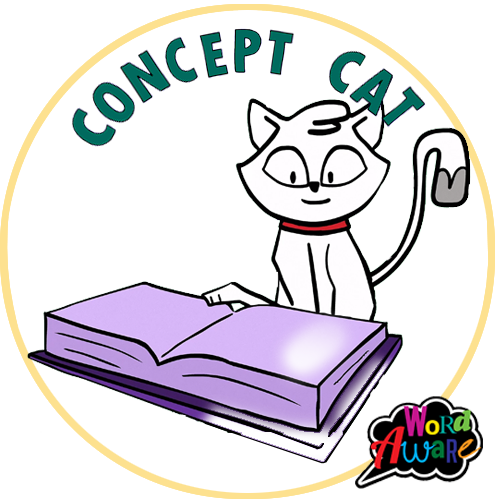Concept Cat Intervention Trial funded by the Education Endowment Foundation and DfE Stronger Practice Hubs
Better Communication CIC is supporting a number of settings as part of a randomised control trial of the Concept Cat programme.
Watch this video to find out more about the Concept Cat intervention:
To find out more about the Concept Cat trial, watch this video including more about who, when and how to get involved:
What is Concept Cat?
The Early Years are when children learn so much about the world around them. Talking and understanding are the bridge to this development, allowing children to interact with others and learn more. For example, when a child learns a word such as ‘first’, they can talk about how objects, people and letters can be placed in order.
Words such as ‘first, through, before, next and forward’ are what we call ‘concepts.’ Concepts are words that are linked to ideas, and so really important for developing thinking. They are more than ‘just another word.’
‘Concept Cat’ is a whole class or group teaching method for early verbal concepts. It was developed by two leading experts in the field Stephen Parsons and Anna Branagan and is part of their ‘Word Aware’ approach. Concept Cat has been used successfully in a range of early years settings, nurseries and schools. The teaching process involves acting out a short story (with a toy cat), singing songs and providing play based opportunities for children. Families are encouraged to be involved too.
Why are we doing this project?
We know early years practitioners, children and families all enjoy Concept Cat. We regularly receive feedback about the progress children make because of Concept Cat activities. There have been some small research studies which have provided promising impacts for children.
Who is involved?
The project is supported by the Educational Endowment Foundation and the Department of Education and in partnership with three Stronger Practice Hubs (Birmingham, Trafford and one more in the North West). The teaching part of the project is run by the authors of the approach together with Better Communication CIC. The research is being run by University of York and RAND Europe.
The project is focussed on early years settings in three geographical areas: West Midlands, Greater Manchester and North West England.
What it involves?
Settings involved in the project must attend training.
Settings are then expected to teach one word per week. This is involves acting out the stories and singing songs at group time. Small changes are made to the learning environment so that children have extra opportunities to learn about the word. If your word of the week was ‘empty’ you could have the water tray, sand tray out that week and at snack time you could talk about empty plates and cups. A couple of times in the week the setting would talk about words that had previously been taught, by using a range of suggested activities. Families would be included, by words and activities in the setting being shared so they can support learning at home.
All settings will be asked to provide some simple data about their settings.
For Wave 2 and 3 settings, there will be a bit more data collected about children, including researchers visiting your setting to do a short assessment with children. Families can opt out if they wish.
Support provided
All settings in the project will be supported by a ‘Concept Cat Coach’ (CCC). These are specially trained speech and language therapists and teachers who will come into a setting each half term to model, coach and support. The CCC will organise group supervision with a lead practitioners in the local area, to facilitate peer to peer learning.
Training is all delivered online by the authors of Concept Cat. This is three hours for the lead practitioner and one hour for all other staff.
Specific resources including a cat toy, puppet, Word Aware 2: Teaching language in the early years book, Word Bag and online access to video resources are all provided.

